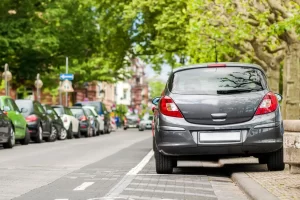How Much Does It Cost to Lease a Car?

If you’re thinking about leasing a car for the first time, you may have a lot of questions about how much you should expect to spend. Leasing a car is a lot like financing one, except that the types of fees you’ll pay are different.
Additionally, you won’t own the vehicle when your lease ends. Instead, you’ll return the car unless you choose to buy it.
Leasing a car can be tricky, especially if you don’t know how much to expect to pay. You may find yourself asking, “How much does it cost to lease a car?” You can expect to pay a variety of fees in addition to your monthly rental agreement fees.
The cost to lease the car depends on several factors, and the fees can be higher than you’d expect. When you have a realistic idea of the cost, you can show up for lease signing with an accurate idea of what you’ll pay.
Leasing a car offers many benefits. For instance, you can get behind the wheel of a new car every few years without taking out an auto loan. If you prefer to drive new cars and don’t care about vehicle ownership, the cost of leasing a car may very well be worth it.
Not interested in leasing? Easily compare auto loan rates below.
AUTO FINANCING
Your one-stop shop for comparing car loans.
Enter your information to see your auto loan options.
How Do Car Leases Work?
The first thing you need to know about leasing a car is that you don’t own the car. You are paying to borrow the car for a specific amount of time. You pay a fee to use the car each month, but you also pay a set of fees when you sign a lease agreement.
Your lease will include stipulations about how many miles you can drive each year and what kinds of wear and tear damage the dealership expects to see by the end of the term.
When you get to the end of your lease term, you have the option to return or buy the car. If you return the car, the dealership will sell the car to somebody else. In this scenario, it’s important that you return the car in good condition.
It should have no damage beyond wear and tear. If other damage does exist, you’ll pay the cost to cover those repairs. You can choose to buy the car at the end of the lease, which means the condition of the car won’t matter.
What Is the Cost to Lease a Car?
The average car lease costs $487 per month. In comparison, the average car payment for a new car is $548. This means that it may be cost-effective for many families to lease cars if they want to get behind the wheel of a brand-new model. Monthly lease payments are determined by the anticipated value of the car when your lease term is over. This is why your lease term typically covers just the depreciation of the vehicle over the course of the time you use it.
The cost of leasing a car is about much more than the monthly payments you make. A car lease includes fees you should understand before you sign the paperwork. Even though your monthly payments might be around $400, you’ll probably need to pay fees at the lease signing.
For instance, you might have $3000 due at signing before you can bring your car home. If your lease lasts three years, this means the cost of your lease is $3000 plus thirty-six payments of $400. At this point, the cost of your lease is $17,400.
Still, this doesn’t factor in the costs of every fee you’ll need to pay. You may also pay more in insurance, extra mileage charges, wear and tear expenses, and more. Even if you choose to buy the car at the end of your lease, you may find that the money you’ve already spent on the car doesn’t matter.
You don’t have equity in the car, so the money you’ve spent on the vehicle doesn’t help you cover keeping the car. If you want to keep the vehicle, you could end up spending a lot more than you expected.
Is It Really Cheaper to Buy a Car?
In some cases, financing a car is a more affordable option for a family. Even if you have the same monthly payment of $400 at thirty-six months, you’ll own the car at the end of the term. You can also put a down payment on your loan, which helps reduce your monthly payments.
If you have good credit, you can potentially get a lower monthly payment with lower interest. When you pay off your auto loan, you then have the option to trade or sell your car.
How Does the Dealership Determine Your Monthly Payment?
Your monthly payment depends on several factors. The main difference between a monthly car loan payment and a monthly lease payment is that the lease payment is not based on the value of the car. Instead, your lease payment is based on the anticipated value of the car by the end of the lease term.
So, this means that the monthly lease payment takes into account the depreciation of the vehicle during the term of the lease. Your monthly payment is also based on several other factors, including:
Lease Term
The lease term is the length of time you agree to lease the car. If you have a shorter lease term, you may end up paying more each month but less in the long term. If you have a longer lease term, you might end up paying less each month but more over the course of the term.
Mileage Expectations
When you sign your lease, you’ll see that there is a specific mileage you can drive each year. For instance, many leases assume that you’ll be driving about 1000 miles per month for a total of 12,000 miles over the course of the year.
If you drive more than this, your monthly payment might go up. If you exceed this mileage by the end of your term, you may owe the dealership more money when you turn in the vehicle.
Taxes and Fees
Taxes and fees are also part of your monthly lease payment. Taxes vary significantly based on where you live. States, counties, and cities have different tax rates, and you’ll see this reflected in your lease paperwork.
Down Payment
You can also provide a down payment at the beginning of your lease term. This is a lot like putting money down when you finance your loan. The more you put down, the lower your monthly payments should be.
What Are the Upfront Car Lease Costs?
When you sign a lease, some fees are due upfront. This means you’ll be paying fees before you drive away with the car.
In many cases, the upfront leasing costs are higher than the upfront costs of buying a car. These are some fees you can expect to pay before you leave the dealership:
Down Payment
In your lease, you might see the down payment referred to as a capitalized cost reduction fee. It varies based on several factors, including the dealer, location, and the car’s value. While some dealerships don’t require any down payment, some payments can be thousands of dollars.
First and Last Monthly Payments
The dealership may require that you put down the first and last payments. For example, if your monthly payment is $400, you can expect to pay a total of $800. To cover your payments if you default on the lease, they could add an additional security deposit.
Acquisition Fee
The acquisition fee is an administrative fee for processing the lease paperwork. It also covers things like verifying auto insurance coverage and checking your credit report. This fee can cost several hundred dollars. The dealership may include documentation fees here as well.
Residual Value
When you sign the lease paperwork, you’ll pay for the residual value of the car. The dealership bases this figure on the expected value of the vehicle by the time the lease is over. The dealership considers the depreciation of the car in helping you figure out your monthly payment as well.
Title and Registration Fees
Before you can leave the dealership with the vehicle, you’ll pay title and registration fees. Every state requires that a car has registration, but the fees for this vary from place to place.
Money Factor
The money factor is similar to the interest rate. The dealership will determine the money factor based on your credit score. If you have a good credit score, your money factor rate will be lower.
What Fees Do You Pay When You Return the Car?
When you return your car at the end of the lease term, you’ll pay additional fees. These fees vary based on several factors, including the condition of the car. These are some of the fees you can expect to pay when you return your car:
Excessive Mileage
While you may have already paid an excess mileage fee, you may pay an additional fee when you return your vehicle per extra mile. For example, your lease may stipulate that you will pay an additional 18 cents for every mile you drive over 12,000 within the year. This fee can add up quickly. For example, putting just 1000 more miles on the vehicle at a rate of 18 cents per mile adds $180 to your return fees.
Excessive Wear and Tear
While some wear and tear is normal, the dealership may determine that the condition of the vehicle is abnormal. If you turn in the car and it’s damaged beyond normal wear and tear, you’ll pay an extra fee.
Your lease will stipulate what constitutes normal wear and tear, but in most cases, this could include damaged upholstery, broken windows, and exterior dents and scratches.
Disposition
The disposition fee, or return fee, is the cost of preparing the vehicle to sell after you return it. When you sign your lease paperwork, this fee should be listed so you can prepare for the cost. In many cases, the return fee is several hundred dollars.
Early Termination
If you choose to end your lease before the term, you’ll pay an early termination fee. This fee can be close to the cost of your entire lease, so it’s often not cost-effective to end your lease early. An exception exists if you have insurance that covers lease termination.
What Are the Benefits of Leasing a Car?
Many people prefer to lease cars rather than finance them. If you’re considering the benefits of a car lease, a few factors may come into play. These are some reasons you may want to lease a car:
Lower Monthly Payments
The monthly lease payments may be much lower than you would pay if you take out a loan for a new car.
In fact, the payments may be a lot lower for a much newer model. If you can’t otherwise afford to drive the same vehicle, leasing it allows you this luxury at a lower monthly rate.
You Get To Drive a New Car
When you lease a vehicle, you can drive a new car every couple of years. When your lease is over, you return the car and sign a new lease on an even newer car if you’d like.
This means you’re always in a new car, which can be nice if you work in a field where you frequently transport or meet clients. This also means you’re always in a safe car with the newest technological features.
Less Maintenance
When you drive a leased car, you don’t have to pay for years of maintenance. You may need to cover services like oil changes, but you likely won’t need to take care of repairs like buying new tires, for example. This can save you time and money in taking care of the vehicle.
What Are the Downsides of Leasing a Car?
Leasing a car isn’t always the best decision, especially if the cost will be more than financing a car. These are some reasons you may not want to lease a car:
You Don’t Own a Car
When your lease is over, you don’t have an asset to show for the money you’ve spent. You may have paid more for your lease than you would’ve paid if you financed a car, but you won’t have anything to show for it. This can be frustrating, especially because you’re paying for the car at its most expensive.
You Have Less Freedom
When you own or finance your vehicle, you have more freedom. You can do things like customize or paint your car. You can also drive as many miles as you’d like. If you don’t like the idea of mileage restrictions, leasing a car may not be an ideal option.
Extra Fees Might Pop Up
You may notice that extra fees can spring up at the end of your lease. While these fees are noted in the lease documents you sign, you may not be aware of the extent of these charges. For example, you may not realize how much they’ll charge you per extra mile you drive over the limit.
Fewer Options at the End of the Lease
At the end of your lease, it may frustrate you that you can’t sell or trade-in your vehicle. As a result, paying for your next vehicle can be more expensive. You’ll have to choose to pay another down payment to lease another car or get an auto loan. In the end, this can add unexpected expenses.
Insurance Costs
One final unexpected cost that pops up is insurance. Your dealership may require that you take on more insurance to cover the leased vehicle. For example, you’ll probably need gap insurance to cover the cost of the vehicle if it’s totaled in an accident. While this is an expense that would also come up with a financed vehicle, you have to maintain gap and comprehensive coverage for as long as you have the leased car.
Car Lease Costs Vary Significantly
The cost to lease a car depends on several factors, so it’s difficult to directly answer the question, “How much does it cost to lease a car?”
As you can see, the value of the car your credit score, and the location all play an important role in figuring out monthly lease payments. Additionally, the monthly payments depend on your down payment, the vehicle you choose, and how you drive the car.
If you want to know exactly how much it costs to lease a vehicle, it’s important to review the lease documents before you sign them. Not only will you pay some of the fees when you sign the paperwork, but you’ll also need to be prepared for return fees.

Finance & Insurance Editor
Elizabeth Rivelli is a freelance writer with more than three years of experience covering personal finance and insurance. She has extensive knowledge of various insurance lines, including car insurance and property insurance. Her byline has appeared in dozens of online finance publications, like The Balance, Investopedia, Reviews.com, Forbes, and Bankrate.




